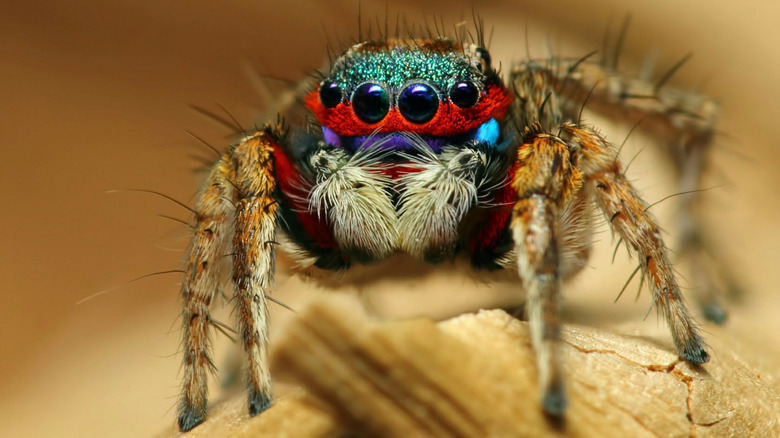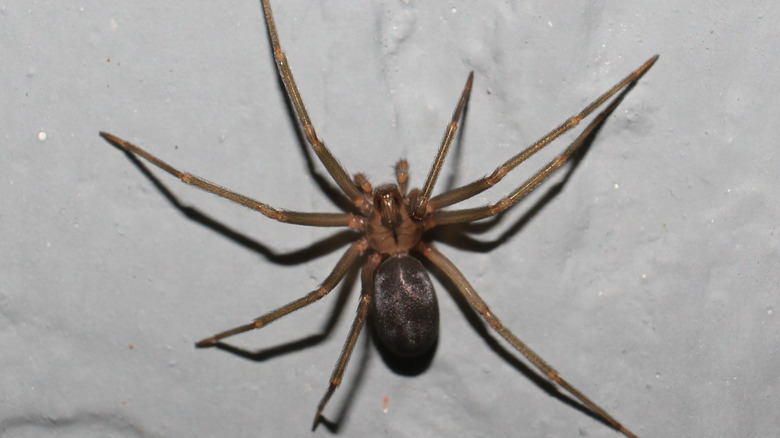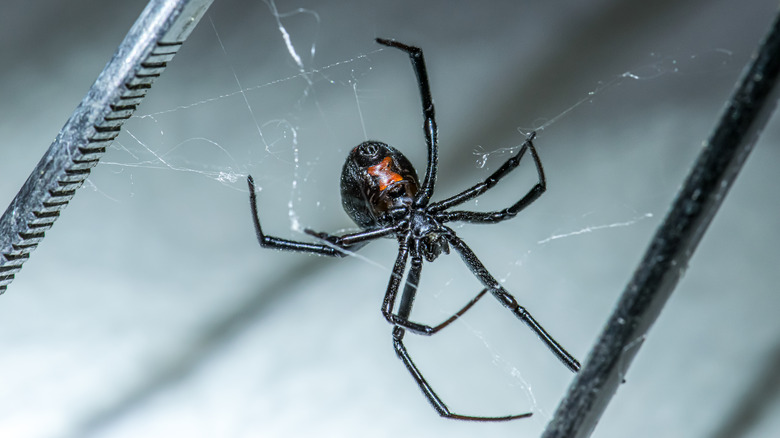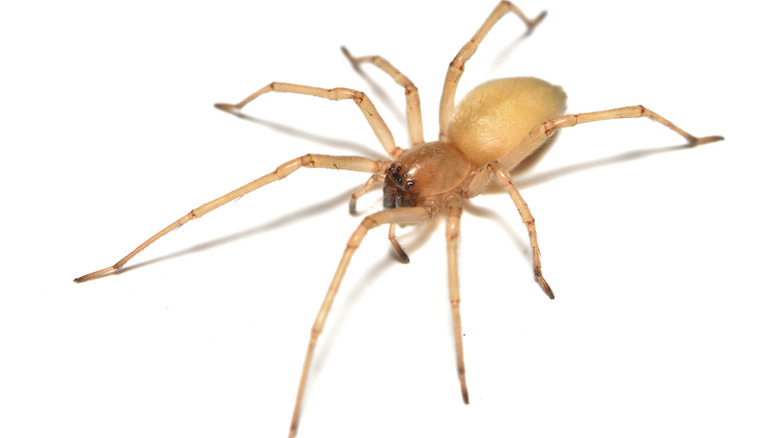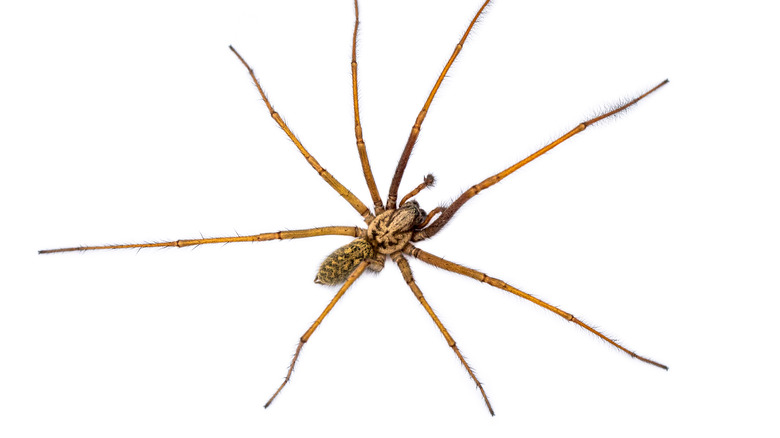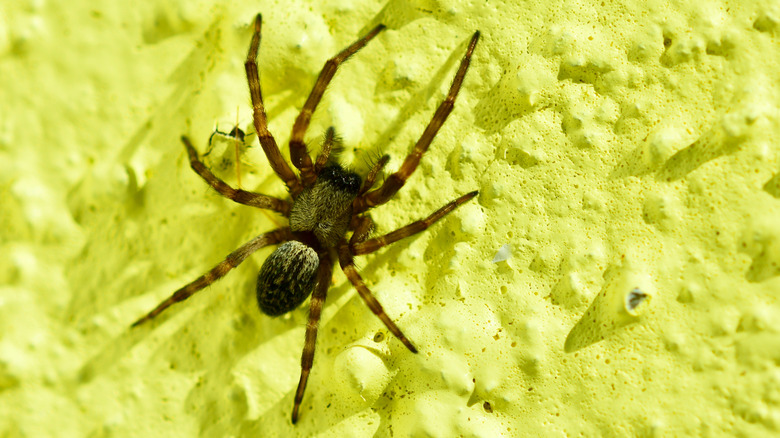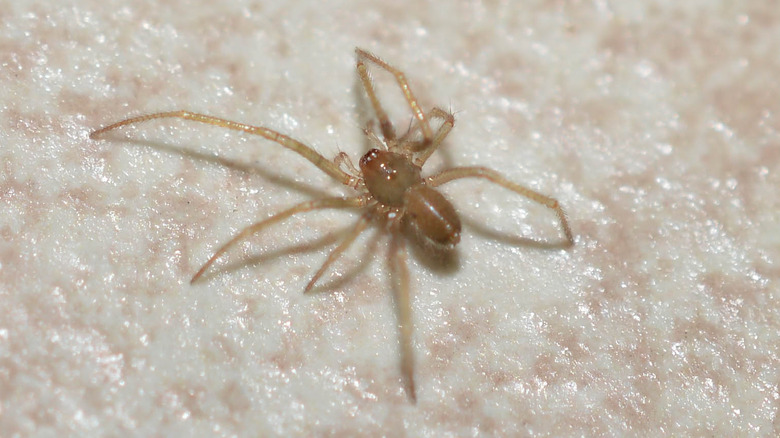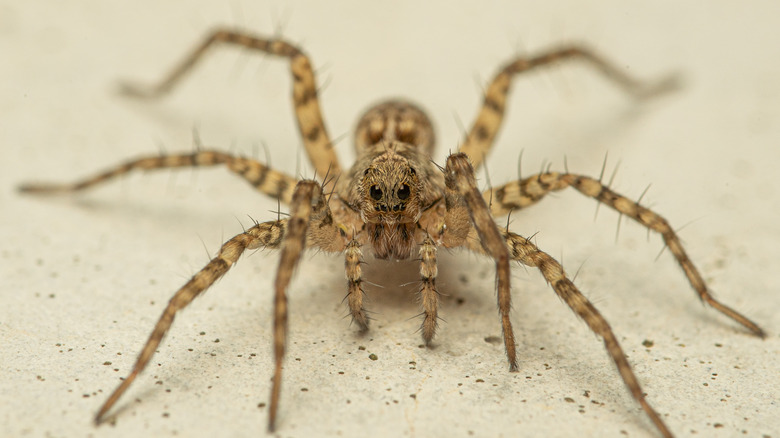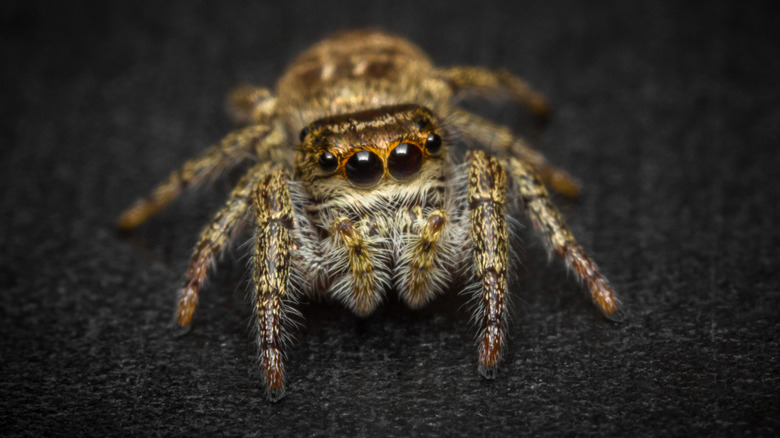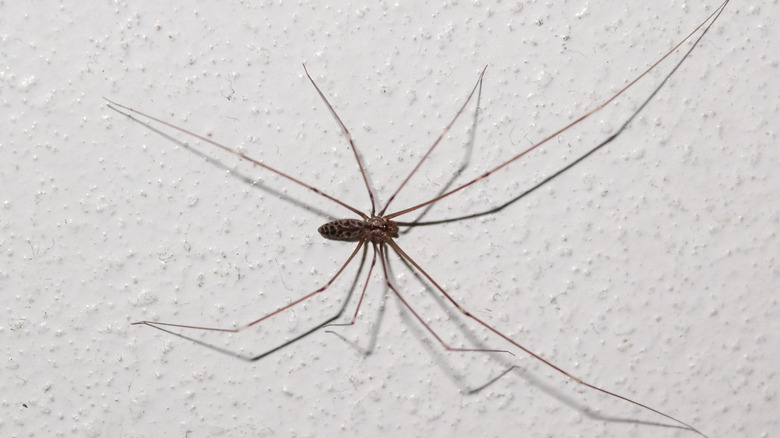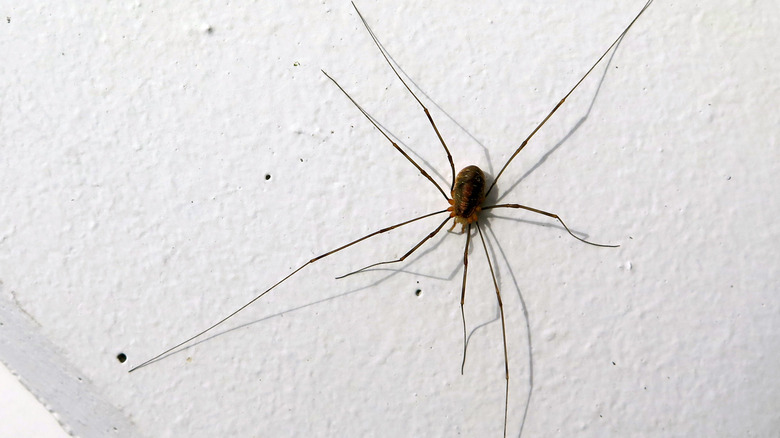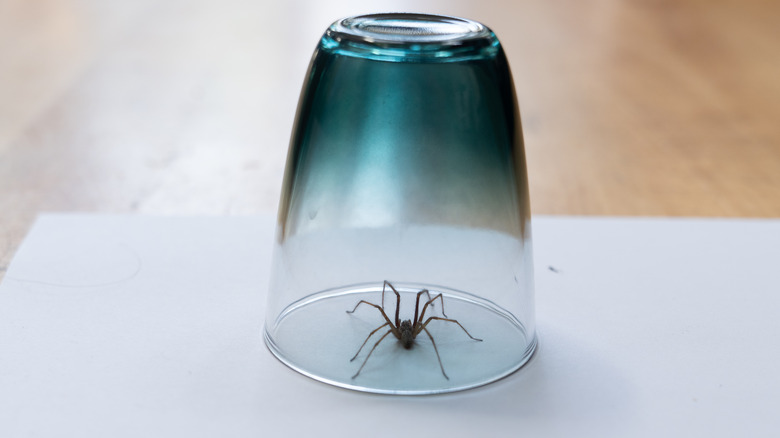10 Types Of Spiders You Might Commonly See In Your Home
If spiders creep you out, you're in good company. According to Psychiatry Associates of Baton Rouge, arachnophobia is one of the most common phobias, with one in every three women and one in every four men experiencing a fear of the critters. To make matters worse, spiders are just about everywhere. All Things Nature notes that there are about 45,000 species of spiders on the earth. With so many of them, it is not surprising that some may find their way into your home.
It is generally easy to identify a spider. Different from insects, which have six legs, spiders have eight legs. Spiders also have two distinct body sections: the cephalothorax, which houses the eyes and the mouth, and its abdomen (via Australian Museum). Insects have three body sections, according to Welcome Wildlife.
While the leggy creatures may look frightening at times, not all spiders are harmful. However, there are decidedly dangerous spiders that give the rest of them a bad reputation. We've compiled a list of the ten most common spiders you might find in your home, starting with the most dangerous.
1. Brown recluse
Brown recluse spiders (Loxosceles) are the most threatening spiders you may find in your home, but that is only if you live in the southern U.S. These spiders can be found in Alabama, Arkansas, Kansas, Louisiana, Oklahoma, Missouri, Mississippi, Texas, and in certain parts of Georgia, Florida, Indiana, Illinois, Iowa, Kentucky, Nebraska, Ohio, and Tennessee, according to Live Science. They like to live in dark, hidden-away areas, such as closets, boxes, or underneath trash cans.
Brown recluse spiders vary in color from light to dark brown, and their bodies are about ⅜ of an inch long (via Sciencing). If you can see one up close, you will notice a marking on the thorax that resembles an upside-down violin or fiddle. Live Science points out that you can also identify the brown recluse by its eyes, of which they will only have six instead of eight. The eyes appear in three sets of two that form a half circle on the front of the spider's "head." Bites from a brown recluse are dangerous, with some resulting in necrosis. That being said, not everyone reacts the same to a bite. If you experience fever, chills, nausea, and an overall sick feeling after a bite, seek medical attention immediately.
2. Black widow
Black widow spiders (Latrodectus) are the second most dangerous spider you could come across in your home. You will probably know it when you see one; they have distinct, shiny, black bodies with red markings on their abdomens that sometimes look like an hourglass. Their bodies are typically 1/2 an inch long, but they can measure out to 1.5 inches if you include their legs.
Like the brown recluse, black widows like dark places. They are not aggressive, but if you put your foot inside a shoe where one happens to be, it will probably bite you to defend itself. The poison of black widow spiders is said to be 15 times more potent than that of a rattlesnake, but because very little venom is released when they bite, it is not usually fatal to humans, according to Animal Diversity Web. That being said, the bites can be dangerous and cause swelling, abdominal pain, and sweating.
3. Sac spider
Sac spiders (Cheiracanthium) are common across most of the U.S. Sac spiders, often called yellow sac spiders, range from light tan to cream in color, and they range from ⅛ of an inch to almost ½ an inch long with their legs. Sac spiders like to live under window sills, in corners, and close to ceilings.
Michigan State University notes that sac spider bites are perhaps the most common spider bites people experience. Sac spiders tend to be more aggressive than other spiders and can bite without a reason. The bites can be painful and might cause a rash along with a burning sensation. Some people may react with a fever and nausea, but overall, bites are not considered serious.
4. Hobo spider
Hobo spiders (Eratigena agrestis) are popular in the Pacific Northwest U.S., and they are part of the funnel-web spider family. Including their legs, they range in size from ¼ of an inch to just over ½ an inch long. Their bodies are light brown with a combination of light and dark markings on the thorax and abdomen. According to Bug Guide, hobo spiders are difficult to identify with the naked eye.
Hobo spiders are not good at crawling, so you might find one trapped in your sink or bathtub on occasion. Their lack of crawling prowess also means that they stick close to floors rather than ceilings (via Utah State University). You will most likely find hobo spiders in your basement or living in dark areas like corners. Bug Guide notes that at one time, hobo spider bites were thought to be dangerous, but there is little evidence that a bite will cause serious damage in most people.
5. American house spider
One of the most common spiders you might find in your home is an American house spider (Parasteatoda tepidariorum). However, you might notice their webs first. These critters like to create somewhat messy-looking cobwebs in the corners of ceilings and windows. American house spiders are not very big, averaging about ½ an inch long, with their two-tone legs. Their light brown abdomens are speckled with black and white spots.
American house spiders are not dangerous to humans, and even better, they are not aggressive. They basically hang out in their webs waiting for unsuspecting prey. Once insects become entangled in the American house spider's web, the spider flings a sticky silk on them that makes escape difficult. These spiders are not bad to have around because they can help keep the amount of bugs you have in your home to a minimum, according to Insect Identification.
6. Southern house spider
Southern house spiders (Kukulcania hibernalis) get their name due to the fact that they are common in the southern portion of the U. S. These grey-brown spiders can get rather large (and intimidating), ranging anywhere from ¼ of an inch to ¾ of an inch long. Their abdomens are thin and darker than their thoraxes.
Much like American house spiders, Southern house spiders make somewhat sloppy-looking webs. According to Louisiana State University, southern house spiders like staying hidden in crevices in the home, so if you do spot one, it may be around a window, where they might have accidentally wandered inside. Southern house spiders are not known to have a dangerous bite.
7. Wolf spider
You might find wolf spiders (Lycosidae) in your home when the temperature begins to cool. They hang out around doors, windows, houseplants, and in garages. Wolf spiders have hairy bodies, with furry legs. These keen hunters are equipped with eight pairs of eyes: a large pair with a smaller pair above and a row of four smaller eyes below. Wolf spiders can get up to just over an inch long, as noted by the Missouri Department of Conservation.
Wolf spiders are not aggressive, but they will bite if they feel threatened. Most people react to a bite with slight pain, redness, and swelling in the bite area. If there is pain, it usually lasts only about 10 minutes. While painful, bites are not known to be harmful to humans. Like the American house spider, the wolf spider will help keep the insect population in your home down, per Wolf Spiders.
8. Jumping spider
Perhaps one of the cutest spiders you might see in your home is the jumping spider (Phidippus audax). Like the wolf spider, the jumping spider has eight eyes, with two large ones that appear to be looking back at you should you ever get close enough to observe one. Animal Diversity notes that jumping spiders have better eyesight than many other spiders. They are relatively small, ranging anywhere from ⅛ of an inch to ½ an inch long.
Jumping spiders have hairy bodies and short legs. Their back legs are strong, giving them the power to jump on their prey. When they leap, they release a line of silk that serves as a lifeline should they fall. Speckles on their abdomen, along with their stubby legs make them somewhat easy to identify. Some even feature red and green colors around their eyes. Finally, jumping spiders are not dangerous to humans and, according to the Midland Reporter-Telegram, you should welcome them into your home because they rid their environments of pesky insects.
9. Cellar spider
Cellar spiders (Pholcidae) get their name because they are known to hang out in dark, damp places like cellars. You can also find them in garages and other dark areas that are relatively quiet. They have long, thin legs and a narrow thorax and an abdomen. Their bodies are light brown and can average about ½ an inch long, but their legs can get as long as 2 inches, which makes them somewhat intimidating.
Cellar spider webs can be messy, and if they are disturbed while in their web, they vibrate in an attempt to confuse predators. Cellar spiders do not bite humans and are not considered harmful in any way, according to Pennsylvania State Extension.
10. Daddy long legs
Another common eight-legged creature you may find in your home is the daddy long legs (Pholcidae), or a harvestman. While these critters might look similar to cellar spiders, they are not technically spiders at all. While they have eight legs, they only have two eyes and they do not have glands that produce venom. They also do not have silk glands that allow them to spin webs. In addition, their body parts appear to be one unit, as opposed to spiders having two distinct body parts. Oddly, their eyes are on top of their torso, according to Texas Master Gardener.
Daddy long legs belong to the Opiliones family, which includes scorpions and ticks. Their small, light brown bodies and remarkably long legs make them one of the creepiest bugs to see. While their bodies are small and roundish — around ¼ of an inch — their legs can be as long as 3 inches. They are not harmful to humans, other animals, or plants.
11. Why it isn't a good idea to kill spiders in your home
Spiders creep many of us out, so our first instinct is often to kill them. However, according to Angi, killing them isn't the best choice. Despite their appearance, they can actually be very beneficial creatures and catch all sorts of pests in their webs — including ants, moths, mosquitoes, and flies. This can help protect your home from becoming infested with these bugs and keep them from causing problems. While many people are afraid of getting bitten, most spiders in the U.S. won't inflict serious pain or injury if they bite you. At worst, a bite may just feel a bit itchy. And, in most cases, you're unlikely to get bitten in the first place unless you're bothering the spider.
If you still aren't on board with letting spiders have free rein in your home, there are alternatives to killing them. Catch them and let them outside using a piece of paper and glass, a gentle insect vacuum, or a pair of manual grabbers that will safely grab the bug and only release it once you're outside and let go of the trigger. Alternatively, you can deter spiders from entering your home or encourage them to leave with certain scents. Arachnids dislike the smell of cinnamon and citrus fruits. Rubbing these ingredients along the walls, floorboards, or window cracks can discourage them from entering your home.

